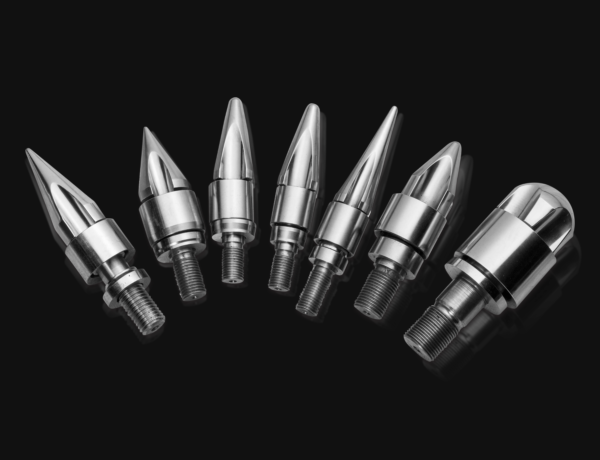Nitrided Cylinders
We offer a wide range of nitrided cylinders.
Hardened Cylinders
We offer a wide range of hardened cylinders for small diameters.
Bimetallic Cylinders
Top grade of our solutions and commenly used are our bimetallic cylinders.
The advantage of our bimetallic alloys
The advantage of our bimetallic alloys is the high and homogeneous hardness throughout the whole layer thickness which ranges from 1.5 to 2 mm thickness. The lifetime increase of the bimetallic cylinder against a nitrided cylinder may exceed 12 times or more. The price-quality-lifetime ratio is therefore very beneficial for the bimetallic cylinder. We have five different alloy solutions listed in the table below. We qualified the quality of the different alloys according abrasion and or corrosion resistance to enable a quick selection.

The advantage of our nitrided and hardened cylinders
The nitrided cylinder obtains its wear resistance from a thin hard top layer of 0.3-0.4 mm applied by gas treatment. It is sufficient for standard polymers without fillers and has a good lifetime price ratio. Hardened materials can also be used for specific cases with small diameters.
-
MM Code
Base Material
Treatment
Abrasion resistance
(x good) to (xxxxx excellent)Corrosion resistance
(x good) to (xxxxx excellent) -
MM31Quenced and TemperedNitriding++
-
MM41Quenced and TemperedNitriding++
-
MM34Quenced and TemperedNitriding++
Bimetallic alloys table
We qualified the quality of the different alloys according abrasion and or corrosion resistance to enable a quick selection.
KB100/109 are general purpose alloys and KB300/350 are alloys for heavy wear applications. See also our material selector.
-
Type
Alloy
Alloy components
Hardness [HRC]
(a) Hardness of matrix, tungsten carbides have a hardness of 89 HRC.Abrasion resistance
(x good) to (xxxxx excellent)Corrosion resistance
(x good) to (xxxxx excellent) -
 KB 100FeNi - C - B58 - 65+++
KB 100FeNi - C - B58 - 65+++ -
 KB 109Fe - CrNi - Mo - Cu - C - B64 - 69++++++
KB 109Fe - CrNi - Mo - Cu - C - B64 - 69++++++ -
 KB 200Ni - CoCr - Mo - B48 - 56++++++
KB 200Ni - CoCr - Mo - B48 - 56++++++ -
 KB 300NiCr - Ni - Co - B - W60 - 66 (a)++++++++
KB 300NiCr - Ni - Co - B - W60 - 66 (a)++++++++ -
 KB 350NiCr - Si - B - W60 - 66 (a)+++++++++
KB 350NiCr - Si - B - W60 - 66 (a)+++++++++

-
TypeKB 100
-
AlloyFe
-
Alloy componentsNi - C - B
-
Hardness [HRC]58 - 65
-
Abrasion resistance++
-
Corrosion resistance+

-
TypeKB 109
-
AlloyFe - Cr
-
Alloy componentsNi - Mo - Cu - C - B
-
Hardness [HRC]64 - 69
-
Abrasion resistance+++
-
Corrosion resistance+++

-
TypeKB 200
-
AlloyNi - Co
-
Alloy componentsCr - Mo - B
-
Hardness [HRC]48 - 56
-
Abrasion resistance+
-
Corrosion resistance+++++
Backing material table
Like 5 different bimetallic alloys, we also working with different backingmaterials. The selection for the right backing material is made on internal process pressure and cylinder design. The different material options garantee a flawless use of the cylinder.
-
Type
Yield point at 300°C
Application
-
KB 25250 N/mm2Extrusion
-
KB 37370 N/mm2Extrusion
-
KB 63630 N/mm2Injection
-
KB 13130 N/mm2Extrusion
-
KB 48480 N/mm2Extrusion & Injection
Example Cylinders

Nitrided Cylinder
Contact us-
Layer1,8509
-
Alloy componentsCr - Al - Ni
-
Hardness [HRC]950-1100 Hv (65-67 Hrc)
-
Diameter [mm]Ø 55
-
Abrasion resistance+
-
Corrosion resistance+

Bimetallic Cylinder KB100/109
Contact us-
LayerKB109
-
Alloy componentsFe - Cr
-
Hardness [HRC]64 - 69
-
Diameter [mm]Ø 200
-
Abrasion resistance+++
-
Corrosion resistance+++

Bimetallic Cylinder KB300/350
Contact us-
LayerKB350
-
Alloy componentsNi - Tungsten carbide
-
Hardness [HRC]60 - 66
-
Diameter [mm]]Ø 150
-
Abrasion resistance+++++
-
Corrosion resistance++++
Discover more products
Other products for injection and extrusion can be found below by clicking on the pictures more information is shown.

 en
en nl
nl de
de it
it es
es












